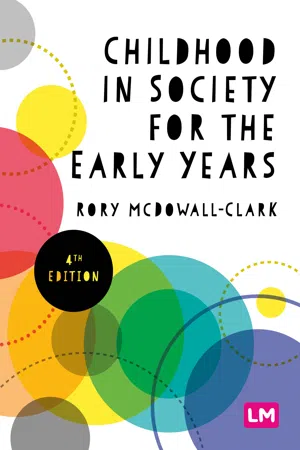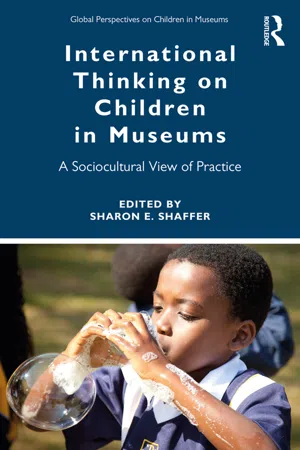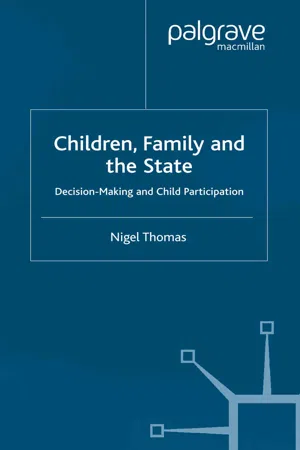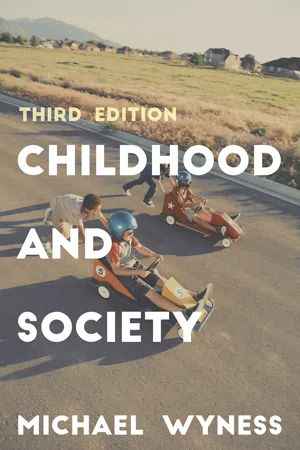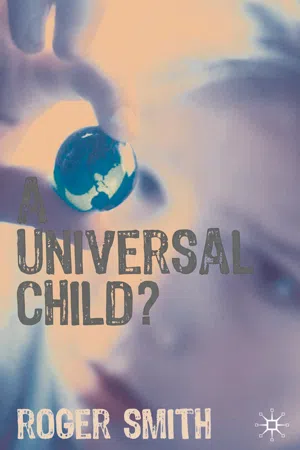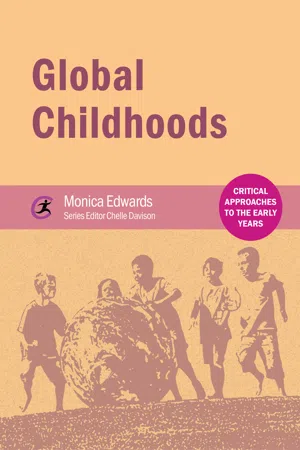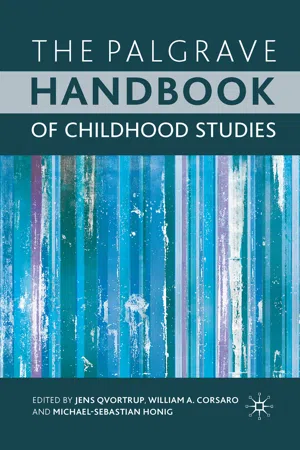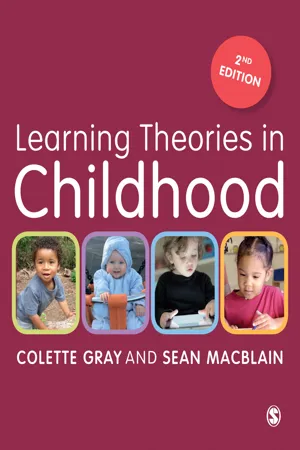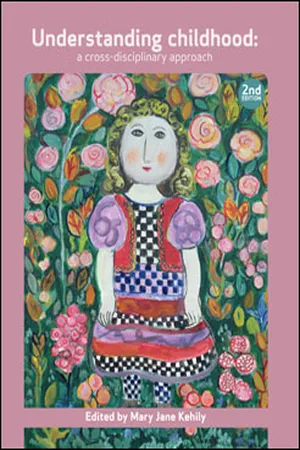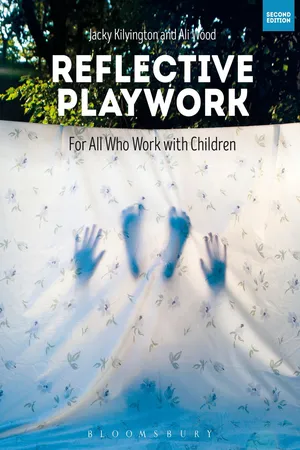Social Sciences
Childhood As A Social Construct
Childhood as a social construct refers to the idea that the concept of childhood is not universal or natural, but rather shaped by social and cultural factors. It emphasizes that childhood is defined and understood differently across societies and historical periods, and is influenced by social norms, values, and expectations. This perspective challenges the notion of childhood as a fixed and unchanging stage of life.
Written by Perlego with AI-assistance
Related key terms
1 of 5
12 Key excerpts on "Childhood As A Social Construct"
- eBook - ePub
- Rory McDowall Clark(Author)
- 2020(Publication Date)
- SAGE Publications(Publisher)
childhood: the state of being a child (this is from Chambers but any dictionary will give similar suggestions). But although such a definition might at first seem unhelpful, it does actually hold the clue to the problem by demonstrating that no agreed definition of childhood can be established in itself, without reference to the social perceptions within which it is experienced. In other words, there is no meaningful definition of childhood that could hold true for all societies and cultures; it will always vary according to cultural norms and expectations. This is what is meant by the claim that childhood is a social construction, as Steve Wagg explains:Childhood, like so many other vitally important aspects of social life – gender, health, youth and so on – [is] socially constructed. It [is], in other words, what members of particular societies, at particular times and in particular places, say it is.(1992, p.10)This means that childhood isn’t ‘natural’ and should be carefully distinguished from biological immaturity (James and Prout, 2015). Therefore, it is evident that there can be no single universal childhood which everybody experiences.Wagg’s assertion is an important one. The emergence of the sociology of childhood during the 1980s and 1990s firmly established the social institution of childhood as separate from the natural biological unfolding of the infant – a perspective which had previously dominated understanding. Although there are clearly universal characteristics of childhood – for instance, the development of emotional bonds and the fact that infants are dependent on others for physical care such as food and shelter – the ways in which these basic human needs are met are infinitely variable. As James and Prout put it:The immaturity of children is a biological fact but the ways in which that immaturity is understood and made meaningful is a fact of culture.(2015, p.7)The idea that childhood is socially constructed should not be confused with the fact that children are the product of their social experiences. It is a statement about the category of people we understand as children rather than about individuals. So although your own experience of childhood is unique to you alone, most readers of this book will nonetheless share the experience of a late twentieth-century childhood in a Western post-industrial economy. That shared childhood is quite different from that experienced by, for instance, a Victorian child, a Japanese child or a refugee child. - eBook - ePub
International Thinking on Children in Museums
A Sociocultural View of Practice
- Sharon Shaffer, Sharon E. Shaffer, Sharon Shaffer, Sharon E. Shaffer(Authors)
- 2020(Publication Date)
- Routledge(Publisher)
In the course of this emerging paradigm, researchers are debating the essence of childhood and the role of children in society, creating both a theoretical and empirical basis for this new area of study. Central to this work is the belief that “childhood is, within this paradigm, to be understood as a social construction” (James and Prout 2015, p. 3), a concept initially credited to Ariès (Corsaro 2018, p. 68). Understanding the child explicitly through a developmental lens is no longer the dominant theory accepted as truth and, with time, may become viewed as a remnant of the past or at the very least, as a complement to new academic theories.William Corsaro, noted author of The Sociology of Childhood (2018), offers additional insight into this notion of Childhood As A Social Construct or “a structural form” and defines it as “a category or a part of society, like social class and age groups” (p. 3). He recognizes children as members or participants of the social group, but only on a temporary basis, while childhood, accordingly, remains “a permanent structural form or category that never disappears, even though its members change continuously” (Corsaro 2018, p. 4). In addition to the idea of Childhood As A Social Construct, Corsaro (2018) suggests a second critical tenet: Children are to be viewed as “active agents who construct their own cultures and contribute to the production of the adult world” (p. 4), consistent with the new sociology of childhood.This rediscovery of childhood (Corsaro 2018), while framed by the distinct tenets described previously, opens debate about many other issues related to children and childhood, and serves as a means to address the marginalization of the past and bring the voices of children to the fore. It moves the discussion beyond the old notions of socialization intended to prepare children for the future to a perspective that regards the child as an active agent with value in the present. It no longer focuses on the child as becoming, but rather sees the child as being - eBook - PDF
Children,Family and the State
Decision Making and Child Participation
- N. Thomas, Kenneth A. Loparo, Jo Campling(Authors)
- 2000(Publication Date)
- Palgrave Macmillan(Publisher)
Prout and James (1990) identify the key features of the new paradigm as follows: 1. Childhood is understood as a social construction. As such it provides an interpretative frame for contextualizing the early years of human life. Childhood, as distinct from biological immaturity, is neither a natural nor universal feature of human groups but appears as a specific structural and cultural component of many societies. 2. Childhood is a variable of social analysis. It can never be entirely divorced from other variables such as class, gender, or ethnicity. Comparative and cross-cultural analysis reveals a variety of childhoods rather than a single and universal phenomenon. 3. Children’s social relationships and cultures are worthy of study in their own right, independent of the perspective and concerns of adults. 4. Children are and must be seen as active in the construction and determination of their own social lives, the lives of those around them and of the societies in which they live. Children are not just the pas- sive subjects of social structures and processes. 5. Ethnography is a particularly useful methodology for the study of childhood. It allows children a more direct voice and participation in the production of sociological data than is usually possible through experimental or survey styles of research. Theories of Childhood 17 6. Childhood is a phenomenon in relation to which the double her- meneutic of the social sciences is acutely present (see Giddens 1976). That is to say, to proclaim a new paradigm of childhood sociology is also to engage in and respond to the process of reconstructing child- hood in society. (pp. 8–9) Prout and James link their work, not only with the insights provided by historians of childhood and with the work of anthropologists in the ‘culture and personality tradition’, but with new developments in the psychological understanding of childhood represented for example by Kessen (1979) and Richards and Light (1986). - eBook - PDF
- Michael Wyness(Author)
- 2019(Publication Date)
- Bloomsbury Academic(Publisher)
As I outlined earlier, one of the key themes within the sociology of childhood now is that childhood has been pluralised; that is, we can bring into being an infinite number of constructions arising out of an infinite number of discourses. Social constructionism thus cannot deal adequately enough with universal notions such as children’s needs or children’s welfare . Woodhead ( 1997 ) in his analysis of the concept ‘needs’, argues that in accentuating the cultural origins of ‘needs’ we tend to obscure the possibility of uncovering conditions and problems that most children face at a global level. Thus the problems of child neglect and abuse and child labour can be found in almost all societies, making it difficult to avoid questions about immanent aspects of childhood that put children in more exploitable positions. In these terms, viewing childhood as a construct generates a relativistic view of childhood. To tie childhood wholly to the context within which we find it is to imply that there is little that can be said generally about the nature of childhood, what Qvortrup views (1994, p. 5) as ‘the preponderance of what is unique over what is common’. Children as constructors? A third question turns on the role that children play within the discourse on childhood. One of the key questions running through the book is the role that children play within society as co-constructors. Are children’s lives merely determined by adults, or do children, as Corsaro ( 2017 , p. 18) con-tends, ‘negotiate, share and create culture with adults and each other’? Social constructionists assume the former in that adults are the creative source here. It is important to be clear about this point. Social constructionists are primarily concerned with how the idea of childhood develops through the intersection of a variety of adult interests. The deconstruction of childhood - eBook - PDF
- Roger Smith(Author)
- 2009(Publication Date)
- Bloomsbury Academic(Publisher)
Thus, it is immediately apparent that quite fundamental definitional issues reflect differing and sometimes competing perspec-tives and modes of understanding of children and childhood, in both academic and social and political spheres. For example, the emerging emphasis on children and their rights associated with some social scientists can be seen as reflecting a committed position which identifies idealized and often normative notions of ‘childhood’ as being oppressive to children. Conventional constructions of ‘childhood’ may therefore be said to disadvantage actual children. Holt (1974) was a key early proponent of this perspec-tive, likening childhood to a prison, whose constraints children should be encouraged to resist and escape from. Franklin (1995), on the other hand, describes Childhood As A Social Construct which is mythologized as a ‘golden age’, worry-free and full of fun. Whichever of these idealized constructions is held, however, they share the tendency to separate childhood and adulthood, and thus to impose another set of limitations on children’s worlds. Modern conceptions of childhood may be seen as stifling and restrictive, to Alternative Perspectives on Childhood 13 the extent that they exclude children from participation in a whole range of ‘adult’ activities; their ideas and feelings are relatively deval-ued, and education in preparation for adult roles and tasks is treated as the major portion and most important aspect of their lives (see, for example, Smith, 2000b). Contemporary developments in the sociology of childhood have tended to follow a similar line. It has been argued that constructions of childhood need to be distinguished from the concrete realities of children’s lives, and studied critically in their own right as social phe-nomena (for example, James et al ., 1998). - No longer available |Learn more
- Monica Edwards, Chelle Davison(Authors)
- 2015(Publication Date)
- Critical Publishing(Publisher)
Critical questions This chapter begins with a question – ‘what is childhood?’ . Having read about the historical perspectives of childhood, reflect upon your initial thoughts when presented with this question. How might historical notions of childhood influence your views on contemporary » childhood issues such as play, the media and technology? Why do you think there is a tendency to focus on Western ideas when seeking » answers to these issues? What can the study of non-Western histories teach us about childhood? » How might your answers challenge the way you now approach the study of childhoods? » The study of children’s historical experiences suggests that the century of the child emerged from prior centuries of childhoods framed by Western societies; the garden of delight that Cunningham ( 2005 , p 172) described was clearly not open to all. This leads to the discussion of how Childhood As A Social Construct is influenced by the same factors that influence wider society. This is a discourse that dominates contemporary discussions about childhood. Contemporary perspectives of childhood If childhood is to be considered as a social construct, which contemporary perspectives of childhood invariably do, then this idea of a social construction requires further exam-ination. The social construction of childhood refers to the meaning given to childhood by What is childhood? • 19 the expectations society places on it. So, for example, the previous section discussed how Western societies’ view of what childhood is and what it should look like has shaped the con-struction of childhood through the last two centuries and into contemporary rhetoric. This is significant because the combined influence of globalisation and technology means there is a far wider reach for such ideas. If Western perspectives dominate contemporary social constructions of childhood, they do not do so unchallenged. - eBook - PDF
- J. Qvortrup, W. Corsaro, M. Honig, J. Qvortrup, W. Corsaro, M. Honig(Authors)
- 2016(Publication Date)
- Palgrave Macmillan(Publisher)
Childhood was conceptualized Method and Methodology in Childhood Research 79 as historically contingent and socially constructed and, more importantly, as a central element of social structure. Furthermore, children were seen as active in the permanent social reproduction of everyday life, of children’s culture and of society. The main objects of sociological childhood research have changed fun- damentally (for recent reviews see Kränzl-Nagl and Mierendorff, 2007; Matthews, 2007; Schweizer, 2007). Thus, it becomes necessary to think about research strategies and methodology to realize and implement these ‘new’ research agendas. Childhood is no longer solely seen, first, as a natural stage in the life course, or, second, as a secure stage of development, but as an element of social structure and as a social context of children’s lives. This context, and especially the sociality of this context, becomes one of the most striking features of, and a theoretical starting point for, research in the field of the ‘new sociology of childhood’ (James and James, 2004; Prout, 2005). This does not mean that ‘old’ methods and traditional knowledge about children have to be abandoned, but methodological access, the choice of methods and the interpretation of data have to be changed. In this context, it has to be mentioned that sociology as an academic discipline itself has not yet developed a very intense concern about the special aspects of researching children. In most textbooks about methods of social research, researching children is not even a topic (see, for example, Diekmann, 2007, for a quantitatively oriented textbook in the German context, and Flick, 2007, for a qualitatively oriented textbook). One of the important theoretical implications of this sociality is that child- hood as an element of social structure has to be understood in terms of its gener- ational order (Honig, 1999; Alanen and Mayall, 2001; Mayall and Zeiher, 2003; Qvortrup in this volume). - eBook - PDF
- Colette Gray, Sean MacBlain(Authors)
- 2015(Publication Date)
- SAGE Publications(Publisher)
Learning Theories in Childhood 154 According to Muñoz (2006, p. 10), childhood studies has three key aims: 1. It seeks to contribute to the social sciences in general by incorporating the voice of one of the most frequently forgotten groups in society: the child. 2. It aims to contribute to the multidisciplinary approach needed to address a complex phenomenon such as childhood by providing a sociological explanation. 3. It makes children visible as active members of society, according to the principles of the UNCRC; it recognizes children as individuals with rights. Thus far, sociologists informed by this rights-based approach have focused on socialization processes or on the analysis of institutions responsible for this social- ization: the family and schools. In adopting this perspective, sociologists focus on the processes that shape childhood rather than on childhood per se. The most influ- ential approaches, to date, include: • The sociology of childhood: Theorists working within this theoretical framework believe that the child should be the unit of investigation. Children are perceived as social actors and therefore researchers should focus on the relationships between a child’s social world and the world of other children and adults. • The deconstructionist sociology of childhood: This approach explores societal beliefs about children and childhood. To understand the construct of childhood, these theorists attempt to understand how society transmits its notions to the child. • The structural sociology of childhood: This perspective considers childhood to be a distinct period in life. Researchers link significant aspects of the child’s life (such as poverty) with macro-level contexts and attempt to explain them in terms of their significance to macro-level mechanisms (Muñoz, 2006). Corsaro (2014) suggested another approach, termed interpretive reproduction. Advocates of this approach view the child as actively interpreting their cultural practices. - eBook - PDF
Growing up in Europe
Contemporary Horizons in Childhood and Youth Studies
- Lynne Chrisholm, Peter Büchner, Heinz-Hermann Krüger, Manuela du Bois-Reymond, Lynne Chrisholm, Peter Büchner, Heinz-Hermann Krüger, Manuela du Bois-Reymond(Authors)
- 2020(Publication Date)
- De Gruyter(Publisher)
Conclusions This contribution has chosen to approach the development and characteristics of the social scientific study of childhood primarily from a methodological point of view. Neither the approach taken, nor the conclusions reached, nor the specification of the direction in which it is desirable to move, will find full or universal agreement amongst those actively involved in the field - nor is such consensus necessary to proceed further. Yet, I think that most active researchers in the field do agree about at least three requirements: firstly, that the focus must be on children or childhood; secondly, that this focus must exhibit features that are non-developmental in the sense of privileging the characterisation of some kind of collectivity of children - be that at a specific level or a general societal level; and thirdly, such research should - directly or indirectly - relate to some reference group, be that along a generational dimension or some other comparative category. Substantially speaking, theories, that characterise childhood inter alia in terms of a minority group, marginalisation, paternalisation (Qvortrup 1994), institutionalisation, or Verhauslichung (Zinnecker 1990a) are promising and fruitful since they may be organi-cally conceived of in terms of more general theories about societal modernisation. This would therefore also stress one last important point, namely that, in my view, children or childhood should not be regarded as something separate from society, as something Childhood in Europe: a New Field of Social Research 19 mysterious, as were they an ontologically different species. Children are human beings, and not merely human becomings; they cannot be seen as 'persons-to-be' who must be integrated into society. If childhood is, then, an integral part of society, it is equally a legi-timate and desirable subject of social scientific inquiry in the same fundamental manner as is any other social phenomenon. - eBook - ePub
Understanding Childhood
A Cross Disciplinary Approach
- Kehily, Mary Jane(Authors)
- 2013(Publication Date)
- Policy Press(Publisher)
Reading A is an extract from Buckingham’s (2011) study of children in the commercial world. The book draws upon Buckingham’s experience as Chair of a government initiative in the UK that responded to concerns of a crisis in childhood by commissioning an independent report to ‘assess the impact of the commercial world on children’s well-being’. As you read through the extract, make notes about how the figure of the child is constructed in consumer culture, and how these ideas might affect parents and society as a whole. Based on your notes and responses to the views expressed, answer the following questions:- How has consumerism changed the experience of childhood?
- How might a social constructionist perspective explain the ‘problem’ of children and consumption?
- Write a short description of your own ideas in relation to these themes. Pay attention to the strength (or otherwise) of your emotional response and where you think these feelings come from.
Figure 6 The proliferation of goods aimed at childrenIn the remainder of this section, we examine the imperative within the new social studies of childhood to attend to children and young people’s experiences and to listen to their own accounts.4.3 Children’s everyday experiences
Although the new paradigm views Childhood As A Social Construction, it does not view individual children and young people as passively constructed through the ideas and practices of the adults around them, or moulded in more diffuse ways by societal forces. One of the foundational principles of the new social studies of childhood is that children should be taken seriously as actively involved in shaping their own lives and the societies around them. As James and Prout explain:The third important feature of the emergent paradigm is that childhood and children’s social relationships and cultures are worthy of study in their own right, and not just in respect to their social construction by adults. This means that children must be seen as actively involved in the construction of their own social lives, the lives of those around them and of the societies in which they live. They can no longer be regarded as simply the passive subjects of structural determinations.(James and Prout, 1997, p. 4) - eBook - PDF
Reflective Playwork
For All Who Work with Children
- Jacky Kilvington, Ali Wood(Authors)
- 2018(Publication Date)
- Bloomsbury Academic(Publisher)
65 4 The Child Chapter Outline Introduction 65 What is a child? 66 Child development and post-developmental theories 70 The sociology of childhood 73 How are children perceived by professionals? 74 Introduction This chapter will analyse what we understand is meant by the word ‘child’ and equally goes on to explore the concept of childhood and how this has changed through history and across the world and continues to do so. We summarize the main theories of child development and how these came about. We look at a sociology of childhood as well as at how the theories and current trends have affected our perceptions of children today. The title of this chapter is in itself a misnomer, because there is no such being as ‘the child’ – indeed childhood and therefore the concept of ‘the child’ is a social construct. That is ‘the under-standing that childhood is not a natural process, rather it is society which decides when a child is a child and when a child becomes an adult’ (Norozi and Moen 2016:5) and this varies from culture to culture and country to country and can be linked to constructs of gender and motherhood which also vary historically and in different societies. Many of us would readily agree that every child is a unique individual with their own needs and interests. But, as with many things, there is a difference between ‘espoused theory’ and ‘theory in practice’ (Argyris and Schon 1974:6–7), or to put it more crudely there is a contrast between what we say or think and what we do. This distinction is usually not intentional because we often do not recognize it exists. We ‘see through a glass darkly’ (1Cor. 13:2) because to be truly objective about who children are requires us to sit outside our experiences, our culture, our society and our time. We need to, as Finlay (2008:6) suggests, ‘engage in critical newgenprepdf - eBook - PDF
Children's Rights in International Politics
The Transformative Power of Discourse
- A. Holzscheiter(Author)
- 2010(Publication Date)
- Palgrave Macmillan(Publisher)
99 An attempt to trace back the history of childhood that governs a contemporary global vision of how a child should grow up in order to become a happy, healthy and educated adult must confront the ques- tion that has been driving historians apart for some considerable time now. Did past societies perceive of younger members of the society as children or minors – that is, as a class of human beings fundamentally different from adults – and did they possess concepts of childhood simi- lar to those prevalent in Western industrialized societies of today? Or are we rather witnessing a historically specific form of modern child- hood that crystallized into a childhood norm in Western societies in the course of the eighteenth and nineteenth centuries (Prout and Allison, 1997: 17)? The most seminal historical accounts dealing with the ‘history of childhood’ in Europe – Philippe Ariès L’Enfant et la Vie Familiale sous l’Ancien Régime (1973) and Lloyd de Mause’ The History of Childhood (1976) 2 – present us with conflicting accounts of when children were first perceived as a distinct social category in society and how they were treated by adults over the past centuries. 3 They also disagree on the question of childhood as a separate life stage. Ariès considers the concept of childhood as a distinct phase in life an invention of the sixteenth century, fortified by the rise of the bourgeoisie in the eighteenth and nineteenth centuries. De Mause claims that it is not childhood that has been subject to changing perceptions, but that only parents’ behav- iour to their children has changed dramatically (see: James and Prout, 1997b: 17). Even though both authors draw attention to the fact that childhood is not a ‘natural’ phenomenon (in the sense that a ‘child’ 5 Discourses of Childhood – the ‘Communicative Ecology’ 1 of the Child
Index pages curate the most relevant extracts from our library of academic textbooks. They’ve been created using an in-house natural language model (NLM), each adding context and meaning to key research topics.
